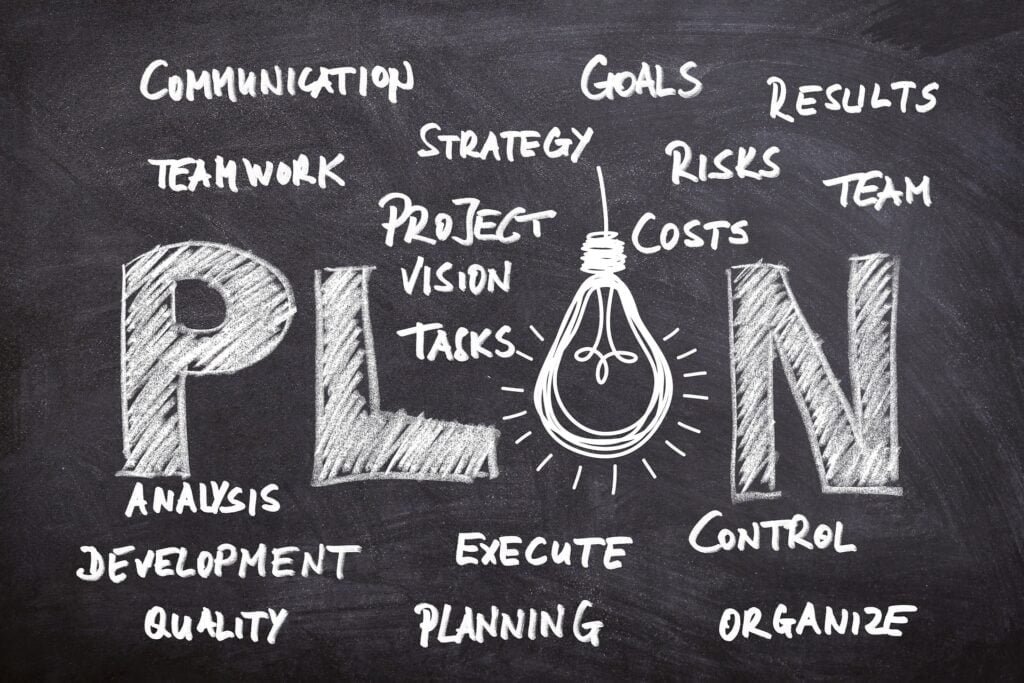Vorige 6 Trends and Developments in Online Marketing
Setting Up a Successful Email Marketing Campaign in 7 Steps
Email marketing is a powerful tool for reaching and engaging your audience. It enables you to communicate directly with potential customers and existing clients, delivering valuable information, offers, and updates. In this blog post, we’ll first explain why email marketing can be effective, discuss common pitfalls, and explore the steps and strategies needed to establish a successful email marketing campaign.

"Email has a capability that many other channels don't: creating valuable, personal touches - at scale."
David Newman Tweet
Why Email Marketing Is Effective
E-mail marketing is a potent strategy that offers numerous benefits to businesses and marketers. Here are some reasons why email marketing is effective:
1. Direct and Personal Contact: Email allows you to communicate directly with your target audience. By sending emails to people who have willingly subscribed to your list, you gain the opportunity to appear in their inbox directly. This creates a personal touchpoint and enables you to send targeted and relevant messages.
2. High Level of Personalization: One of the significant advantages of email marketing is the ability to personalize messages. You can tailor emails based on recipients’ preferences, interests, and demographic information. By providing relevant and personalized content, you increase engagement and the likelihood of conversion.
3. Targeted and Measurable Results: One of the significant advantages of email marketing is the ability to personalize messages. You can tailor emails based on recipients’ preferences, interests, and demographic information. By providing relevant and personalized content, you increase engagement and the likelihood of conversion.
4. Increased Conversion and Customer Engagement: Email marketing can contribute to increased conversion and customer engagement. By providing relevant and valuable content, you can pique the interest of recipients and prompt them to take action. This can result in higher conversion rates, such as completing a purchase, downloading a whitepaper, or signing up for an event.
5. Cost-Effective and Time-Efficient: Email marketing can contribute to increased conversion and customer engagement. By providing relevant and valuable content, you can pique the interest of recipients and prompt them to take action. This can result in higher conversion rates, such as completing a purchase, downloading a whitepaper, or signing up for an event.
Additionally, you can use emails to build a long-lasting relationship with your customers. By consistently sharing valuable content, you can strengthen the trust and loyalty of your audience. This can lead to repeat purchases, recommendations, and a positive brand experience.
In summary, email marketing is an effective strategy with numerous advantages. It enables direct interaction with your target audience, offers opportunities for personalization and segmentation, and contributes to increased conversion and customer engagement. Moreover, it is cost-effective and time-efficient. Thus, including email marketing in your overall marketing strategy is certainly worthwhile.
Search Clicks can, of course, assist you in setting up your email marketing campaign. Therefore, feel free to contact us after reading this article and let us convince you of the added value for your company.
Pitfalls of Email Marketing

While email marketing can be an effective strategy, there are also some common pitfalls to be aware of. Here are some of the common pitfalls of email marketing:
1. Spam Filters and Deliverability
One of the major challenges in email marketing is ensuring that your emails actually reach the inboxes of your recipients. Spam filters have become increasingly sophisticated and can sometimes mark legitimate emails as spam. To improve deliverability, it’s important to ensure that your emails comply with relevant anti-spam laws, such as obtaining recipient consent and providing an easy way to unsubscribe.
2. Excessive Promotion-Oriented Content
Another pitfall is sending too much promotional content. If your recipients are constantly inundated with offers and advertisements, it can lead to irritation and unsubscribes. It’s important to strike a balance between promotion and valuable content. Make sure you share valuable information, tips, educational content, and exclusive offers to maintain recipient engagement.
3. Non-Personalized Messages
A lack of personalization can also be a pitfall in email marketing. Sending generic, non-personalized emails can make your messages less relevant to recipients. It’s essential to utilize available data and segmentation options to deliver personalized content that aligns with the interests and needs of your recipients. This increases the likelihood of engagement and conversion.
4. Poor Mobile Experience
With the growth of mobile usage, it’s essential to ensure that your emails are optimized for mobile devices. If your emails don’t display well on smartphones and tablets, it can result in a poor user experience and reduced engagement. Ensure that your emails are responsive and that the content is easy to read and navigate on mobile devices.
5. Lack of Measurability and Optimization
Another pitfall is the lack of measurability and optimization. It’s crucial to monitor and analyze the performance of your email campaigns. This includes tracking open rates, click-through rates, conversion rates, and other relevant statistics. With this data, you can gain insight into the effectiveness of your campaigns and make optimizations to achieve better results.
It’s important to avoid these pitfalls and take a strategic approach to email marketing. By addressing these challenges and following best practices, you can enhance the effectiveness of your email campaigns and achieve success in your marketing efforts.
Now that we’ve discussed the benefits of email marketing and the pitfalls, we’d like to outline the steps necessary to set up a successful campaign.
Email Marketing: The Step-by-Step Plan

Step 1: Build Your Email List
The success of your email marketing campaign begins with a high-quality email list. Ensure you have the permission of your recipients to send them emails. Collect email addresses through your website, social media, events, or other channels. Offer valuable content or incentives to encourage people to subscribe to your newsletter.
Step 2: Define Your Goals and Target Audience
Before you dive into your email marketing campaign, it’s crucial to define your goals and target audience. What do you want to achieve with your campaign? Do you aim to generate more sales, increase customer loyalty, or share news? Also, define your target audience: who are your ideal recipients, and what are their areas of interest? This will help you create targeted and relevant emails.
Step 3: Choose an Email Marketing Service
To efficiently manage your email marketing campaign, you’ll need a reliable email marketing service. Several platforms are available, such as MailChimp, ConvertKit, and Campaign Monitor. Choose a platform that suits your needs and budget and allows you to design, send, and analyze emails.
Step 4: Create Valuable and Engaging Content
The success of your email marketing campaign hinges on the content you provide. Ensure that you create valuable and engaging content that is relevant to your target audience. Personalize your emails, tell a story, and offer exclusive deals or content. Additionally, consider mobile optimization and ensure an appealing layout.
Step 5: Automate Your Email Flows
Automation is a powerful tool for optimizing your email marketing campaign. Set up automated email flows based on the actions and behaviors of your recipients. Send welcome emails, abandoned shopping cart reminders, birthday offers, and follow-up emails to boost engagement and encourage conversions.
Step 6: Test and Optimize
A successful email marketing campaign requires ongoing testing and optimization. Experiment with different subject lines, calls to action, timing, and content to discover what works best for your audience. Analyze the statistics and gather feedback to continuously improve and optimize your emails.
Step 7: Monitor and Analyze Your Results
Monitoring and analyzing your email marketing campaign is essential to gain insights into your performance. Keep track of key statistics such as open rates, click-through rates, conversions, and unsubscribe rates. Use this data to understand what works and what doesn’t, and adjust your strategy as needed
Conclusion
With these steps and strategies, you’re well on your way to a successful email marketing campaign. Always keep the needs and interests of your audience in mind and maintain consistency in your communication. With the right approach and tools, you can build valuable relationships and grow your business through email marketing. Of course, email marketing is just one of the tools you could use. We’ve previously written an article about the benefits of SEO and how important the right content on your website is. Take the time to read through the articles if you have the chance.
Do you have any more questions about setting up a successful email marketing campaign? Check the frequently asked questions for more information.
Now that you have a solid understanding of the basics of setting up a successful email marketing campaign, you can get started and grow your business through effective email communication. Good luck
Frequently Asked Questions

The ideal number of emails per month varies depending on your business and target audience. Test different frequencies and analyze the response. Ensure that you regularly provide valuable content, but avoid over-sending to prevent overwhelming recipients.
Yes, personalizing your emails can increase engagement and response. Use the recipient’s first name in the greeting and tailor the content based on their interests and preferences whenever possible.
Monitor key statistics such as open rates, click-through rates, conversions, and unsubscribe rates. Compare these figures to your goals and analyze trends. Also, use A/B testing to compare the performance of different elements in your emails.
Some essential emails to include in your email flows are welcome emails, abandoned shopping cart reminders, thank you emails after a purchase, and follow-up emails after an interaction. Customize your email flows based on your business and your target audience’s needs.
Ensure that your emails are responsive and display well on various devices and screen sizes. Test your emails on mobile devices to ensure they are easy to read and navigate.
